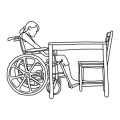1. Access and Referral Pathways
One of the primary distinctions between NHS and private community rehabilitation lies in how individuals access these services. Under the NHS, referral is typically initiated by a GP or a hospital specialist following an assessment of your needs. This process often involves detailed documentation and can be accompanied by waiting lists, as demand for NHS rehabilitation is high and resources are allocated based on clinical urgency. In contrast, accessing private community rehabilitation is generally more straightforward. Individuals may self-refer or be referred by any healthcare professional, with far fewer administrative barriers. Waiting times in the private sector tend to be much shorter, enabling quicker commencement of therapy. However, this efficiency comes at a cost, as private services require out-of-pocket payment or suitable insurance cover. Ultimately, the role of your GP is pivotal within the NHS pathway—acting as both gatekeeper and ongoing point of contact—while private options offer greater autonomy and flexibility for those able to fund their own care.
2. Cost and Funding
When considering community rehabilitation options in the UK, one of the most significant differences between NHS and private services is the way they are funded and accessed. Understanding these distinctions can help individuals and families make informed decisions about the best route for their unique circumstances.
NHS Community Rehabilitation: Free at the Point of Access
The NHS operates on a principle of providing healthcare free at the point of use, funded through general taxation. This means that eligible residents can access community rehabilitation services such as physiotherapy, occupational therapy, or speech and language therapy without having to pay directly for their care. However, NHS services may require a referral from your GP or another healthcare professional, and waiting times can sometimes be lengthy depending on local demand.
Private Community Rehabilitation: Direct Payment and Insurance
In contrast, private community rehabilitation services are typically paid for out-of-pocket or via private health insurance. This route offers greater flexibility and choice in terms of providers, appointment times, and potentially quicker access to care. Private practitioners may offer home visits or clinic-based sessions tailored to individual needs. Costs can vary widely based on location, type of therapy, and session duration.
Comparison Table: NHS vs Private Rehabilitation Funding
| Aspect | NHS Community Rehab | Private Community Rehab |
|---|---|---|
| Cost to Patient | Free at point of use | Direct payment/Insurance required |
| Funding Source | Public (via taxation) | Private funds or insurance |
| Referral Needed? | Usually required from GP or NHS specialist | No referral needed; self-referral possible |
| Waiting Times | May experience delays due to demand | Typically shorter; more immediate access |
| Service Scope | Covers essential needs as per NHS guidelines | May offer wider range and more specialised services |
This difference in funding structure means that while the NHS ensures equitable access regardless of income, private rehabilitation provides additional choice but comes with extra costs. It’s important to weigh up both your financial situation and your need for timely or specialised care when deciding which path to pursue.

3. Scope and Range of Services
When considering community rehabilitation options in the UK, the range and type of services offered can vary significantly between NHS and private providers. NHS community rehabilitation typically delivers a comprehensive, multidisciplinary approach. This often includes access to physiotherapists, occupational therapists, speech and language therapists, and sometimes psychologists or dietitians. However, the availability of these specialisms may depend on local NHS resources and priorities, which can occasionally lead to waiting lists or limitations on session frequency.
In contrast, private community rehab services tend to offer greater flexibility and a wider selection of therapies tailored to individual needs. Many private providers boast a broader array of interventions such as hydrotherapy, advanced neurological rehabilitation, specialist pain management, or even holistic therapies like yoga and mindfulness. This personalisation extends not only to therapy type but also to scheduling, allowing for more intensive or frequent sessions if desired.
The NHS’s strength lies in its integrated care model and its commitment to evidence-based practice for the wider population. Private rehab, meanwhile, is often valued for its capacity to deliver bespoke care plans and prompt access to niche therapies that may not be available through public funding. Ultimately, the diversity and individualisation of services represent a key difference between these two pathways—an important consideration when choosing the most suitable support for your rehabilitation journey.
4. Quality, Standards, and Regulation
When considering community rehabilitation options in the UK, understanding the differences in quality assurance, regulatory oversight, and service standards between the NHS and private sector is essential for making an informed choice. Both sectors are committed to delivering effective care, but their approaches to regulation and quality control can vary.
Regulatory Bodies
| Provider Type | Main Regulatory Body | Key Responsibilities |
|---|---|---|
| NHS | Care Quality Commission (CQC) | Inspects services, ensures safety, effectiveness, and high standards of care |
| Private Sector | Care Quality Commission (CQC), plus additional independent accreditations | Inspects services, may have extra voluntary certifications such as ISO standards or memberships with professional bodies |
Quality Assurance Measures
The NHS operates under nationally mandated clinical guidelines—such as those from NICE (National Institute for Health and Care Excellence)—ensuring consistency and adherence to evidence-based practice across all its community rehabilitation services. Audits, patient feedback mechanisms, and internal reviews further strengthen quality assurance within NHS provisions.
Private providers are also regulated by the CQC but often implement supplementary quality assurance frameworks to remain competitive. This might include seeking external accreditation or tailoring service delivery for specific client needs. However, variation exists: some private providers excel with innovative approaches, while others may not consistently match NHS standards.
Potential Variations in Service Standards
| Aspect | NHS Community Rehab | Private Community Rehab |
|---|---|---|
| Consistency of Standards | Generally uniform due to national policy and oversight | Can vary significantly depending on provider and accreditation pursued |
| Transparency of Outcomes | Publicly reported through CQC ratings and NHS audits | CQC reports available; additional outcome data may be less accessible or more varied in detail |
| User Involvement in Service Design | Service user feedback mechanisms widely embedded across NHS trusts | User involvement depends on provider ethos; some offer highly personalised care plans, others less so |
Navigating the Choices with Confidence
For individuals seeking community rehabilitation in the UK, being aware of these regulatory frameworks and variations in service standards can provide reassurance and help guide decision-making. Whether choosing NHS or private options, it is advisable to review CQC inspection reports, ask about quality assurance processes, and consider how each provider responds to patient feedback. Ultimately, a well-informed approach supports both peace of mind and better rehabilitation outcomes.
5. Availability and Waiting Times
One of the most significant differences between NHS and private community rehabilitation options lies in the availability of appointments and the length of waiting times. Within the NHS, demand for rehabilitation services is high, which often results in longer waiting periods before an initial assessment or ongoing therapy sessions can be scheduled. Waiting times may vary greatly depending on your local area, with rural regions sometimes facing even greater delays due to limited resources and fewer specialist practitioners.
In contrast, private rehabilitation providers typically offer much quicker access to services. Appointments can often be arranged within days or weeks, rather than months, providing a more immediate response for those seeking support. This can be particularly important following hospital discharge or after experiencing a sudden health setback when timely intervention is crucial for optimal recovery.
Geographical disparities are also notable: while some urban centres may have multiple private clinics and shorter NHS waits, people living in remote or underserved communities might find both options less readily available. Private providers may not always operate in these areas, potentially necessitating travel for treatment, whereas NHS services strive to maintain local accessibility but are constrained by funding and staffing limitations.
Ultimately, the choice between NHS and private community rehabilitation will often come down to how urgently you require support and what is realistically available in your locality. Considering both your personal circumstances and the broader regional context can help you make an informed decision that best supports your health and wellbeing.
6. Patient Choice and Personalisation
One of the most significant differences between NHS and private community rehabilitation lies in the level of choice and personalisation available to patients. In the NHS, rehabilitation plans are typically developed through collaboration between clinicians and patients, but choices may be limited by resource constraints, standardised care pathways, and therapist availability. Patients often receive appointments based on local service schedules, with less flexibility in selecting appointment times or locations. Additionally, continuity of care can vary, as you might not always see the same therapist for each session.
By contrast, private rehabilitation providers generally offer a far greater degree of personalisation. Patients have more influence over their treatment plans, often being able to choose from a wider range of therapies and approaches tailored to their individual needs and goals. There is usually flexibility in scheduling sessions at times that fit around work or family commitments, including evening or weekend appointments. Private settings also frequently allow patients to select their preferred therapist or request a change if they feel another professional might be a better fit.
Location is another area where private options stand out; many providers offer home visits or sessions in comfortable clinic environments closer to where you live or work. This convenience can make it easier to maintain regular attendance and maximise the benefits of your rehabilitation plan.
Ultimately, while both NHS and private services strive to support patient recovery, those seeking more autonomy and bespoke care may find private rehabilitation better meets their preferences for choice and personalisation. However, it is important to consider factors such as cost and accessibility when weighing up these options.
7. Aftercare and Ongoing Support
When it comes to aftercare and ongoing support, the approach can differ significantly between NHS and private community rehabilitation options. Within the NHS, continuity of care is a key principle. Patients are usually provided with follow-up appointments, regular check-ins, and access to multidisciplinary teams who work together to support recovery post-discharge. There may also be community-based services such as home visits from physiotherapists, occupational therapists, or district nurses, all coordinated through your GP or local NHS trust. However, due to demand on NHS resources, there may sometimes be waiting lists for ongoing therapy or limitations in the frequency of follow-up sessions.
In contrast, private providers often offer more tailored and flexible aftercare packages. These might include more frequent follow-ups, direct lines of communication with therapists, and personalised support plans that adapt as your needs change. Some private services offer additional amenities such as out-of-hours contact, bespoke exercise programmes, and even family education sessions to help everyone involved understand how best to support your recovery at home. This individualised approach can feel reassuring, particularly if you prefer continuity with a specific therapist or require more intensive ongoing input.
It’s important to weigh up what level of aftercare will suit your circumstances best. The NHS provides a safety net for all, ensuring nobody is left without support following rehabilitation, but private providers may offer that extra layer of flexibility and immediacy that some families find invaluable during the longer journey of recovery.


